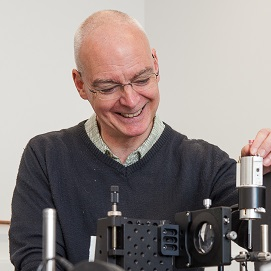Raman Spectroscopy: A Spectroscopic 'Swiss-Army Knife'
A special issue of Molecules (ISSN 1420-3049). This special issue belongs to the section "Analytical Chemistry".
Deadline for manuscript submissions: closed (15 December 2018) | Viewed by 119823
Special Issue Editor
Special Issue Information
Dear Colleagues,
Since its first report by Raman and Krishnan in 1928, Raman spectroscopy has become an important form of vibrational spectroscopy in the physical and biological sciences. This Special Issue aims to encompass a number of diverse studies which exemplify the usefulness of this technique in these areas. This will include the use of Raman spectroscopy as an analytical tool in biological and materials sciences, as well as its use as a structural tool in molecular electronic materials and in dynamic systems—such as in photocatalysis.
In the effort to celebrate Raman spectroscopy, experts working with this technique are cordially invited to submit manuscripts. Particular interest is given to new innovations in the field that have enhanced the capability of Raman spectroscopy—on any type of sample.
Prof. Keith C. Gordon
Guest Editor
Manuscript Submission Information
Manuscripts should be submitted online at www.mdpi.com by registering and logging in to this website. Once you are registered, click here to go to the submission form. Manuscripts can be submitted until the deadline. All submissions that pass pre-check are peer-reviewed. Accepted papers will be published continuously in the journal (as soon as accepted) and will be listed together on the special issue website. Research articles, review articles as well as short communications are invited. For planned papers, a title and short abstract (about 100 words) can be sent to the Editorial Office for announcement on this website.
Submitted manuscripts should not have been published previously, nor be under consideration for publication elsewhere (except conference proceedings papers). All manuscripts are thoroughly refereed through a single-blind peer-review process. A guide for authors and other relevant information for submission of manuscripts is available on the Instructions for Authors page. Molecules is an international peer-reviewed open access semimonthly journal published by MDPI.
Please visit the Instructions for Authors page before submitting a manuscript. The Article Processing Charge (APC) for publication in this open access journal is 2700 CHF (Swiss Francs). Submitted papers should be well formatted and use good English. Authors may use MDPI's English editing service prior to publication or during author revisions.
Keywords
- Raman spectroscopy
- Raman microscopy
- Imaging
- Chemometrics
- Surface-Enhance Raman
- Spatially-Offset Raman
- Two-Dimensional correlation
Benefits of Publishing in a Special Issue
- Ease of navigation: Grouping papers by topic helps scholars navigate broad scope journals more efficiently.
- Greater discoverability: Special Issues support the reach and impact of scientific research. Articles in Special Issues are more discoverable and cited more frequently.
- Expansion of research network: Special Issues facilitate connections among authors, fostering scientific collaborations.
- External promotion: Articles in Special Issues are often promoted through the journal's social media, increasing their visibility.
- e-Book format: Special Issues with more than 10 articles can be published as dedicated e-books, ensuring wide and rapid dissemination.
Further information on MDPI's Special Issue polices can be found here.






